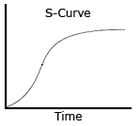Diffusion of innovations
Diffusion Theory
Diffusion theory is a model that explains how innovation is spread and adopted throughout a society. Adopters of innovation are categorized as innovators, early adopters, early majority, late majority and laggards. The Diffusion of Innovation model was developed by Everett M. Rogers, and uses an S-curve to graph the adoption of an innovation. Diffusion theory is used in many disciplines to explain trends, economic patterns, health and medical concerns and technology innovations. This model is an important part of change management and contains four key elements:
1. What is the innovation?
2. How is it communicated?
3. The idea is transmitted over time
4. The idea is diffused to members of the society
Adopters of innovation experience five stages of diffusion:
1. Knowledge - awareness of the idea and perceived benefit
2. Persuasion – convinced of the value of the innovation
3. Decision – judgment to adopt the innovation
4. Implementation – in acting the innovation
5. Confirmation - acceptance or rejection of the innovation
Jim Wright 13:41, 24 June 2007 (CDT)
The Innovation
New innovations follow a pattern of development. The steps include identifing a need or problem, research and development, commercialization of the innovation, and the diffusion and adoption process. After an innovation is adopted certain consequesnces follow.
Tricia Cauffiel 22:43, 2 July 2007 (CDT)
Communication Channels
Time
The Social System
Consequences of Diffusion
Many innovations cause both negative and positive consequences. The adoption of new ideas within a social system can produce desirable or undesireable changes. Some changes have direct or indirect consequences. While others cause anticipated or unanticipatied consequences. The main purpose of diffusion is to maintain dynamic equilibrium which is the ability to cope with the amount of change the is being diffused.
Tricia Cauffiel 22:26, 2 July 2007 (CDT)
Reference
Rogers, E., (2003). Diffusion of Innovations, 5th Edition. New York: Free Press.
